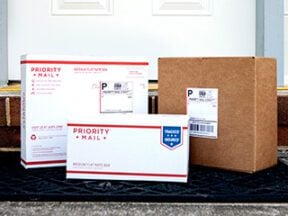John Melizanis believes third-party logistics fees often produce surprise charges. Per-item pricing for picks, packs, and receiving can turn an anticipated $1 per order fee into $2.50 or more, he says.
John is the co-founder of ShipDudes, a New Jersey-based 3PL launched in 2020. His company uses flat-rate pricing for pick-and-pack and warehousing, and no markup for shipping. “Brands appreciate knowing their exact costs,” he told me.
In our recent conversation, John addressed the origins of ShipDudes, in-store retail, warehouse automation, and more.
The entire audio of our conversation is embedded below. The transcript is edited for clarity and length.
Eric Bandholz: What do you do?
John Melizanis: I’m a co-founder of ShipDudes, an omnichannel fulfillment company in New Jersey. We help ecommerce brands ship worldwide and break into physical retail. We’re the behind-the-scenes engine for many companies sold in Sephora, GNC, and Vitamin Shoppe.
Beyond shipping, we support brands with EDI integrations, labeling, and compliance, essential for clients entering retail for the first time. Retail logistics can be demanding; missed labels or late deliveries can result in chargebacks. We’ve built systems to handle these challenges both operationally and technologically.
We serve three primary channels: direct-to-consumer, marketplaces such as Amazon and Chewy, and in-store retail. Our tech stack integrates across all of them. We initially developed custom software, but now utilize a white-labeled platform that we’ve heavily customized.
I began fulfilling orders in a garage, using shipping software Pirate Ship and dropping off hundreds of packages at the post office. As we evolved into a full 3PL, it became clear that some fulfillment platforms fall short in terms of inventory tracking and order verification. Our system tracks everything — pick, pack, and ship — down to barcode scans.
Bandholz: How do you handle custom packaging?
Melizanis: We understand that some brands require custom inserts, folded boxes, or more intricate packaging. Internally, we group clients into three phases: startup, scale-up, and enterprise. It’s not just about size but also how operationally mature the brand is.
We support complex packaging needs but also offer guidance on ways to simplify without sacrificing brand identity. Some brands follow our advice, others don’t, but we always offer it.
Bandholz: What about employee training?
Melizanis: It all starts with a process. If the process is solid and an employee still struggles, he’s likely not a good fit.
Every pack station has printed standard operating procedures in English and Spanish, with visuals — key for our Spanish-speaking staff. We emphasize the importance of their work: “Someone paid $100 for this order. How would you feel getting the wrong item?”
We instill that mindset daily to build pride and ownership. Cameras at each station provide accountability. If there’s a customer issue, we review the footage. If it’s a recurring mistake, we coach, revisit SOPs, and retrain.
It’s not perfect. Some hires won’t work out. But we give everyone a fair shot. If they can’t follow the process, they’re not right for the team.
Bandholz: What’s the future of robotic picking?
Melizanis: I’ve seen hybrid systems with robots retrieving from bins like giant vending machines. They’re not as expensive as you’d think and can run 24/7. We’ll likely invest in something like that for picking in the next few years.
Still, people aren’t going away entirely. Many of our clients expect a high-touch experience, including custom tissue paper, inserts, and folded boxes. That level of care still needs a human. I see automation handling repetitive tasks such as picking, while packing remains more manual for brands that value the unboxing experience.
Picking is a major expense. In a 50,000-square-foot warehouse, walking from one item to another adds up quickly. Automation could significantly reduce those costs.
But packing is also expensive, especially for premium brands. It requires someone who understands the brand and packs thoughtfully. Ever get a small item in a giant Amazon box? That’s what happens when automation replaces human oversight.
Automation can optimize picking, but humans remain vital for packing, especially when presentation matters.
Recommended

Lessons from Changing 3PLs
October 11, 2024
Bandholz: How can brands reduce 3PL and shipping costs?
Melizanis: It starts with product design. Size, weight, and fragility all impact expense. Bigger items cost more to ship and pack. Brands with low SKU variation and simple products are far easier and cheaper to fulfill at scale.
The ideal ecommerce product is small, lightweight, durable, and fits in a bubble mailer. That minimizes fulfillment costs and maximizes margins. Not every brand can do that, but if you’re developing products, it’s worth giving serious thought to.
As for shipping costs, we use different carriers for different needs. For small, lightweight, durable products, DHL and regional carriers such as Lone Star Overnight, TForce Freight, and OSM can be cost-effective.
For larger or heavier items, USPS has robust programs, and FedEx and UPS offer solid, reliable service, although they tend to be more expensive. For customer experience, FedEx or UPS Ground is probably your best bet.
People often forget about injection points. Where your package enters the carrier network matters. A rural USPS drop-off might be slower (or faster) than one in a metro hub, depending on the volume and routing.
There’s no one-size-fits-all. You need to match the right carrier to your product type, ship-from location, and customer expectations.
Bandholz: Does ShipDudes use itemized pricing like most 3PLs, or flat rates?
Melizanis: We avoid itemized pricing. Most 3PLs have multiple fees — picks, inserts, receiving, spot checks. Brands sometimes think they’re paying $1 per order but end up paying $2.50 or more.
We use a flat pick-and-pack rate. Multiply your orders by that rate, and that’s what you pay — no surprises. We calculated it based on the average number of picks per order.
We handle storage the same way: one all-in pallet fee, no added spot check or counting charges. We’re not the cheapest or most expensive, but we’re the simplest. Brands appreciate knowing their exact costs.
We also eliminated the typical 3PL communication mess. Every brand gets a dedicated Slack channel with on-site support and account managers.
Shipping is our third and final billing item, and it’s a pass-through. We negotiate competitive rates, calculate all surcharges, and pass them along directly. It saves clients time, money, and confusion.
Bandholz: How can people connect with you?
Melizanis: Our website is ShipDudes.com. Check out our podcast, “New Money Talks.” I’m on LinkedIn.




